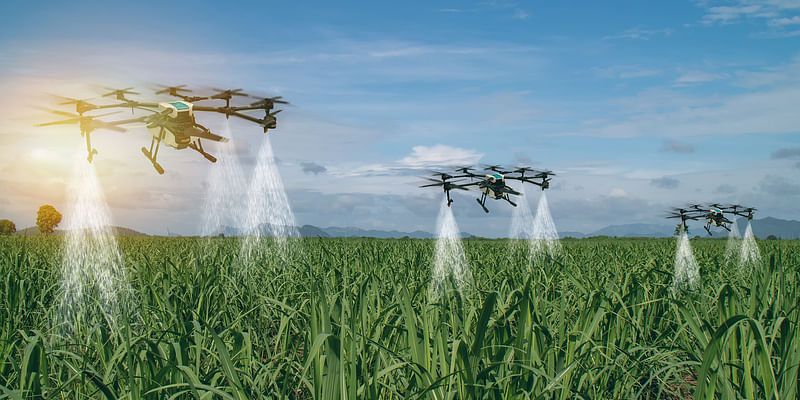
In India, where agriculture is a way of life rather than just a mere means of livelihood, it has been seeing a revolution over the past decades that has the potential to transform farming practices, making them more efficient, sustainable, and profitable.
The catalyst behind this change is the adoption of drone technology. Drones—also known as Unmanned Aerial Vehicles (UAVs)— have found their wings in Indian farms, and the impact they are having is notably remarkable.
Drones or UAVs are converting the abstract concept of precision agriculture into a tangible reality. Let’s delve into the multifaceted ways drones are transforming agriculture through compelling data and actionable insights.
Remote sensing and monitoring
Crop health remains paramount for maximum yield, which helps farmers to earn better profits. Drones—armed with state-of-the-art technologies like hyperspectral imaging—have revolutionised the way we perceive crop health. These nimble UAVs can capture images at incredibly high spatial and spectral resolutions, enabling the early detection of a wide array of issues.
In a recent study, drones were able to identify pest infestations up to two weeks earlier than traditional monitoring methods, translating to potentially saving up to 30% of the harvest that otherwise might be lost.
In India, where farming practices are as diverse as the culture itself, these drones are more than just eyes in the sky. They serve as advanced decision support systems, facilitating targeted intervention and reducing the waste of critical resources like water, chemicals, and fertilisers.
Moreover, the high-resolution imagery from drones allows farmers to identify the exact locations of these issues. This precise information is invaluable as it enables targeted intervention and prevents the unnecessary application of treatments across the entire field. This kind of precision can make a world of difference.
Precision crop management
India, like many other countries, faces the challenge of balancing agricultural production with environmental preservation. The overuse of chemicals and water can lead to soil degradation and contamination of water sources.
Drones are not limited to surveillance. When coupled with the right analytical capabilities, the raw data can be transformed into actionable insights for real-time crop management.
For instance, by utilising the drone-acquired and analysed data, farmers can reduce fertiliser usage by an average of 26% by applying it only where it’s needed. It is not just a financial boon but a leap towards sustainable agriculture that mitigates environmental impact.
Efficient field scouting
Given India’s vast geographical expanse, monitoring remote or hard-to-reach farms is a unique challenge. Here, drones are an asset, reducing the hours of manual labour involved in field scouting to mere minutes.
According to recent estimates, drones can cover 200 acres in just 30 minutes, offering timely and accurate data. It is valuable for smallholder farmers, who make up close to 68% of the Indian farming community, enabling them to act before a problem like a pest infestation becomes economically damaging.
This efficiency in field scouting allows farmers to stay ahead of potential issues, even in remote or less accessible parts of their farms. Instead of labour-intensive, time-consuming manual inspections, drones provide a cost-effective and timely alternative.
Data-driven decision making
We’re in an era where data-driven strategies are not the exception but the rule, and agriculture is keeping pace. Drones generate extensive datasets that offer an in-depth look into crop health, growth patterns, and other variables.
For example, a farmer in Uttar Pradesh can now optimise planting densities of sugarcane based on drone-collected data, potentially increasing yields by up to 10%.
Imagine a farmer in the heart of Punjab who can now use drone-acquired data to optimise planting densities, manage nutrients effectively, and plan their harvest with precision. Such data-driven decisions can lead to higher yields and, consequently, better profits.
Enhanced sustainability
Sustainable farming practices are a necessity for the future of agriculture, and drones are playing a vital role here. They help lower the environmental impact of agriculture by reducing the overuse of chemicals and water.
Water scarcity and environmental degradation are immediate concerns that agriculture must reckon with. Drones contribute to alleviating these issues by precisely identifying areas requiring water or treatments. By doing so, water usage can be reduced by an estimated 25%, furthering the cause of sustainable agriculture.
Cost savings
In a sector where profit margins can be wafer-thin, drones serve as a cost-effective ally. Early detection of potential issues allows for timely and, therefore, less costly interventions. By helping farmers make data-backed decisions, drones help avert financial setbacks, offering an ROI that far exceeds their initial cost.
The cost savings from drone technology go beyond just reacting to problems. Drones can provide insights that lead to proactive measures. By advising on agri-input use before visible crop issues occur, they can prevent the need for expensive interventions later during the crop cycle.
Weather forecasting
For a good yield, optimum weather remains crucial. Equipped with weather monitoring technology, drones can serve as weather stations in the sky, providing real-time data on the weather.
This information is invaluable for planning farm operations and responding to changing weather patterns. In India, where monsoons can be a farmer’s best friend or worst enemy, having up-to-the-minute weather data is a game-changer. It allows farmers to make informed decisions about when to plant, irrigate, or harvest, ultimately improving farm resilience.
Conclusion
Drones are much more than high-tech gadgets. They are catalysts propelling agriculture into an era of increased efficiency, sustainability, and profitability.
As the Indian government shows a growing affinity for precision agriculture, drones stand to become a cornerstone of the sector. This blend of traditional farming wisdom and cutting-edge technology promises a brighter, more prosperous future for agriculture in India.
Amandeep Panwar is the Co-founder and CEO of BharatRohan.
Edited by Suman Singh
(Disclaimer: The views and opinions expressed in this article are those of the author and do not necessarily reflect the views of YourStory.)










